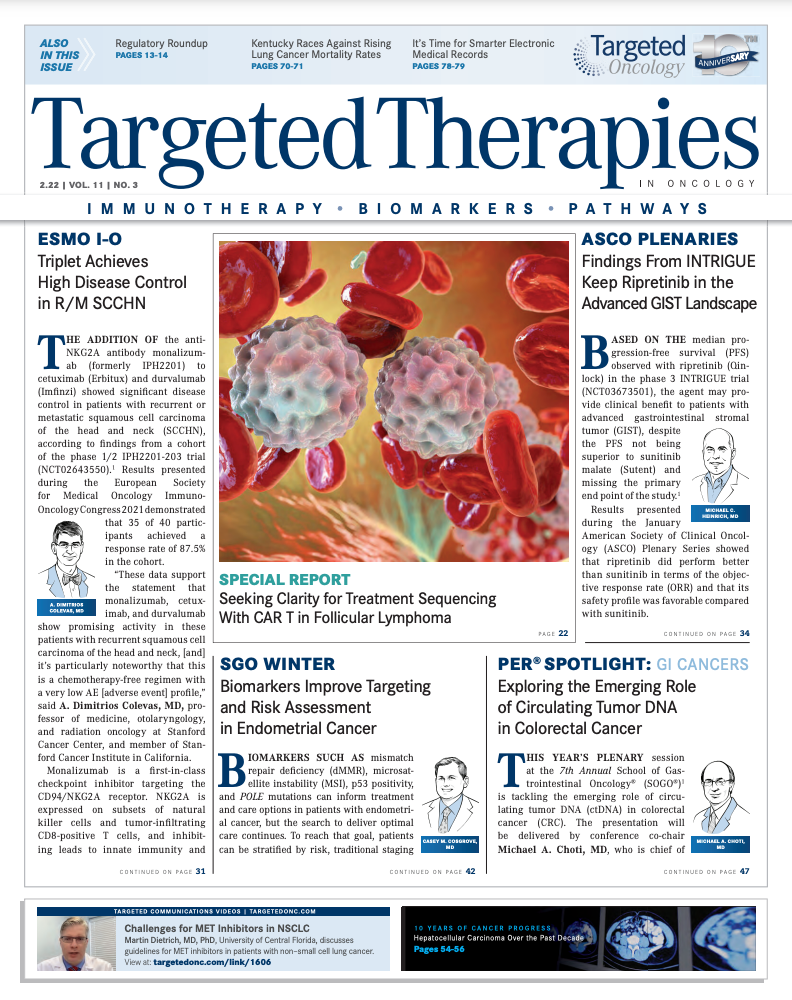Exploring the Emerging Role of Circulating Tumor DNA in Colorectal Cancer
For localized colorectal cancer, the use of circulating tumor tDNA for both quantitative and qualitative detection can inform the risk of recurrence and metastatic dissemination.
Michael A. Choti, MD, MBA

This year's plenary session at the 7th Annual School of Gastrointestinal Oncology® (SOGO ) is tackling the emerging role of circulating tumor DNA (ctDNA) in colorectal cancer (CRC). The presentation will be delivered by conference co-chair Michael A. Choti, MD, who is chief of surgery at Banner MD Anderson Cancer Center in Gilbert, Arizona.
For localized disease, the use of ctDNA for both quantitative and qualitative detection can inform the risk of recurrence and metastatic dissemination. In CRC, ctDNA has been thoroughly studied.2
“I’m fortunate to be delivering the plenary session,” Choti said in an interview with Targeted Therapies in OncologyTM. “It’s exciting because this is going to be a transformative [tool]....” He noted that the use of ctDNA is selective, with some aspects covered by insurance and others that are more limited. ctDNA allows for a greater understanding of the tumor’s molecular genetics; its advantage over biopsy is that it can be used to determine the full genomic profile of a patient with cancer.
Another evolving use of ctDNA is for monitoring a particular treatment. For example, if a patient with advanced disease is being treated with chemotherapy, the traditional way to measure response is to have the patient undergo scans a month or 2 after delivery of the drug. If ctDNA is being used for monitoring, the oncologist can see a difference in tumor burden, sometimes even 1 day or a week later, noted Choti. “It gives the physician the ability to nimbly adjust therapy to determine if that therapy is working,” he said. The advantage is that the patient is not subjected to treatments that are not working or to extensive adverse events.
From a longitudinal standpoint, ctDNA can inform clinicians about changes in the clonal composition of tumor tissue over time, which can lead to further stratification of treatment. Performing liquid biopsies that isolate and analyze ctDNA at different time points can alert the clinician to heterogeneous changes during treatment. Based on this concept, more precise therapeutic schedules can be formulated for patients with cancer in different stages.3
Choti cautioned that although this is exciting, “what’s needed is to get the word out in the community so that clinical trials can be designed and enrollment can begin that will [eventually] validate the concept.”
The overall goal of the conference emphasizes the multidisciplinary care that is required for patients with gastrointestinal (GI) cancers. Choti and his co-chair, John L. Marshall, MD, chief, Division of Hematology/Oncology at Medstar Georgetown University Hospital; professor of medicine and oncology, Lombardi Comprehensive Cancer Center at Georgetown University; and director, Ruesch Center for the Cure of Gastrointestinal Cancer, structured the conference to highlight practical application of knowledge to the complex care scenarios encountered in practice settings, rather than taking an esoteric approach.
Medical Crossfire®
In addition to the plenary session, Choti also emphasized the Medical Crossfire® session, which will explore the role of immunotherapy in GI cancer. Early immunotherapy experience in GI cancers was not well received, with negative findings from trials and minimal advancements. But that has changed with the incorporation of immune checkpoint inhibitors in upper GI cancers.
For example, the FDA approved nivolumab (Opdivo) in combination with chemotherapy for advanced or metastatic gastric cancer, gastroesophageal junction cancer, and esophageal adenocarcinoma.4
In the randomized, multicenter, open-label CheckMate 649 trial (NCT02872116), investigators enrolled 1581 patients with previously untreated advanced or metastatic gastric cancer, gastroesophageal junction cancer, or esophageal adenocarcinoma.

Findings demonstrated a statistically significant improvement in progression-free survival (PFS) and overall survival (OS) for patients with PD-L1 with a combined positive score (CPS) of 5 or greater.
Median OS was 14.4 months (95% CI, 13.1- 16.2) in the nivolumab plus chemotherapy arm vs 11.1 months (95% CI, 10.0-12.1) in the chemotherapy alone arm (HR, 0.71; 95% CI, 0.61-0.83; P < .0001).
Median PFS was 7.7 months (95% CI, 7.0- 9.2) in the nivolumab plus chemotherapy arm vs 6.0 months (95% CI, 5.6-6.9) in the chemotherapy alone arm (HR, 0.68; 95% CI, 0.58-0.79; P < .0001). Longer follow-up data confirmed nivolumab plus chemotherapy as a new standard first-line regimen.5
Tumor Board
A tumor board featuring real cases will be co-chaired by Choti and Marshall. Participants can look forward to a lively interaction that will foster the exchange of ideas, best practices, and collaboration.
REFERENCES
1. 7th Annual School of Gastrointestinal Oncology® (SOGO®). PER®. Accessed January 26, 2022. https://event.gotoper.com/event/ abe9cf63-574f-4ea6-abe7-311bb50cab5a/summary
2. Dasari A, Morris VK, Allegra CJ, et al. ctDNA applications and integration in colorectal cancer: an NCI Colon and Rectal-Anal Task Forces whitepaper. Nat Rev Clin Oncol. 2020;17(12):757-770. doi:10.1038/ s41571-020-0392-0
3. Xu C, Cao H, Shi C, Feng J. The role of circulating tumor DNA in therapeutic resistance. Onco Targets Ther. 2019;12:9459-9471. doi:10.2147/OTT.S226202
4. FDA approves nivolumab in combination with chemotherapy for metastatic gastric cancer and esophageal adenocarcinoma. FDA. April 16, 2021. Accessed January 26, 2022. https://bit.ly/32yIWLQ
5. Janjigian YY, Ajani JA, Moehler M, et al. Nivolumab (NIVO) plus chemotherapy (Chemo) or ipilimumab (IPI) vs chemotherapy as first-line (1L) treatment for advanced gastric cancer/gastroesophageal junction cancer/esophageal adenocarcinoma (GC/GEJC/EAC): CheckMate 649 study. Ann Oncol. 2021;32(suppl 5):S1283-S1346. doi:10.1016/annonc/annonc741
